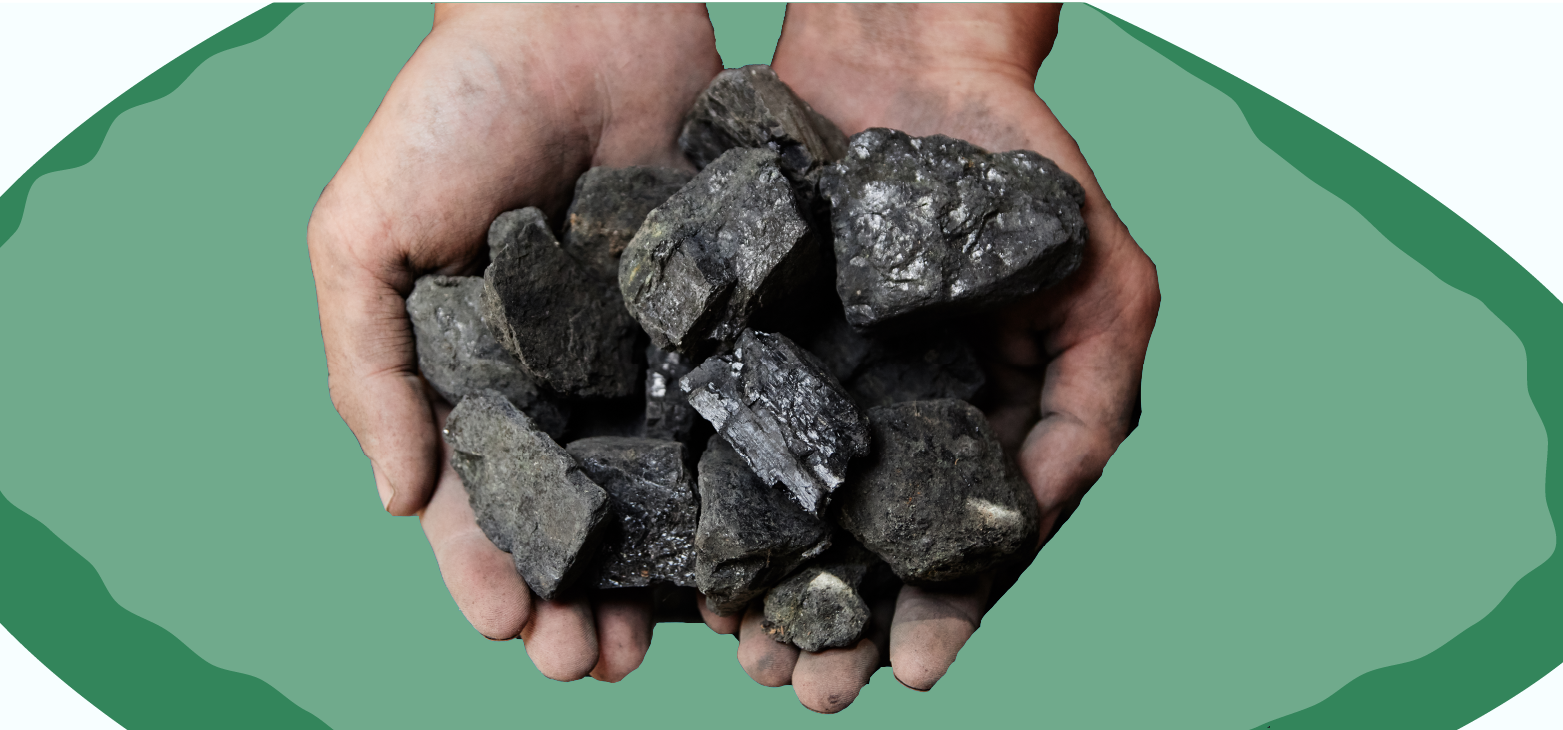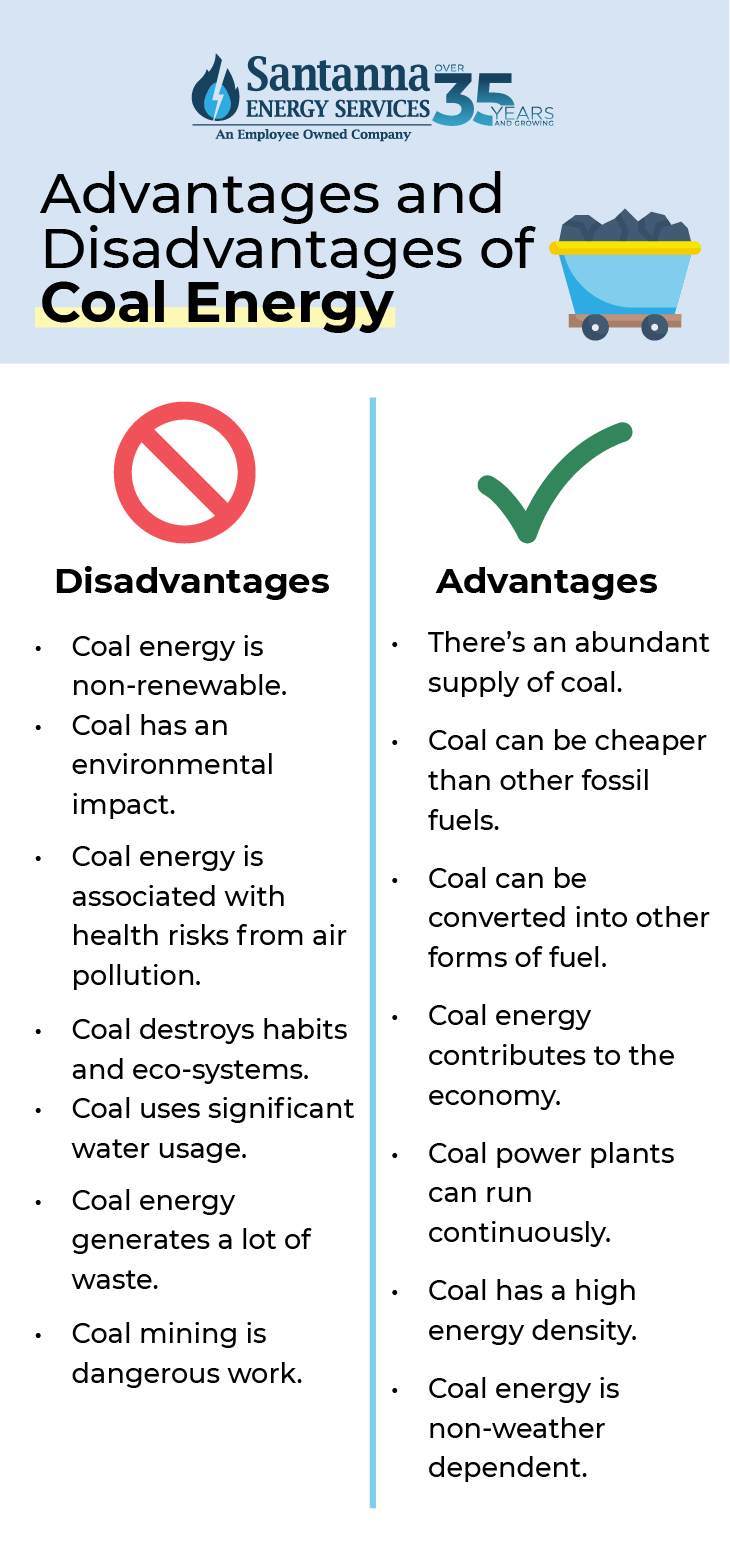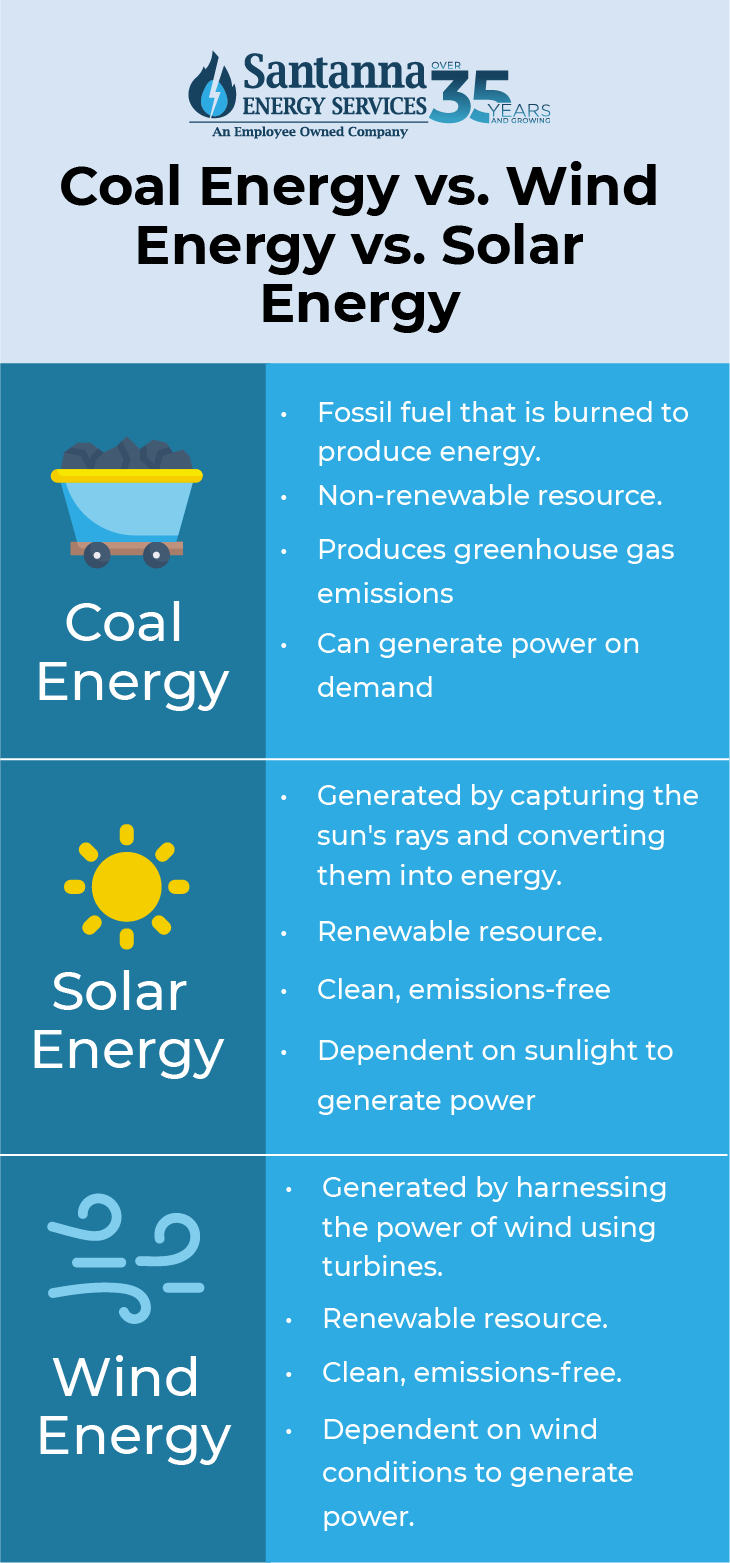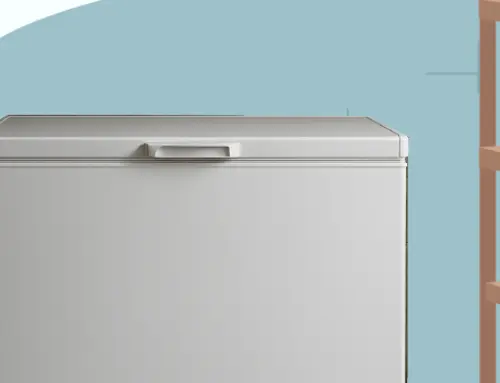14 Disadvantages & Advantages of Energy from Coal
by Tyler Castle
16.2 min read

Coal has been primarily used as fuel for energy sources for decades, supplying electricity to millions of homes. The heat generated from burning coal is used to turn water into high-pressure steam, which powers a turbine to generate electricity.
As we explore new ways to meet energy needs, understanding the benefits and challenges of coal energy helps us make informed choices for the future. Whether you’re focused on your family’s well-being or exploring ways to manage your energy costs, we’ll provide insights into the role of coal in energy production and the pros and cons to this energy source, so you can make the best decision for your home.
What is Coal and What are the Most Common Types?
According to USGS, coal is a type of rock made mostly of carbon that can easily burn. It’s usually black or dark brown and is made up of over half its weight and most of its volume from carbon-rich material.
Coal forms over millions of years as plants get buried, squeezed, and changed by heat and pressure deep underground. Coal has many types, and these are the most common:
- Anthracite: The highest grade of coal, known as hard coal, is shiny, hard, and brittle. It has a high carbon content and low volatile matter, making it very efficient for heating.
- Bituminous: A mid-grade coal used for electricity and steel production in the U.S. It has high heat output and a layered, shiny appearance mixed with dull layers.
- Subbituminous: A dull, black coal with moderate heat output. It’s mainly used for generating electricity due to its lower carbon content and efficiency.
- Lignite: Also called brown coal, it’s the lowest grade of coal. It has a high moisture content, low heat value, and is mostly used for power generation.
Which Type of Coal Has the Greatest Energy Potential?
According to E.I.A., anthracite has the highest energy potential among all coal types due to its superior heating value with a carbon content of 86% to 97%, However, it is rare in the United States, making up less than 1% of coal production in 2022. The only anthracite mines in the U.S. are located in northeastern Pennsylvania.
How Many People Use Coal Energy to Power Their Homes?
According to E.I.A., the United States made a huge amount of electricity—about 4.18 trillion kilowatt-hours (kWh)—from big power plants in 2023. That’s enough electricity to power almost everything in the country!
Most of the electricity produced in 2023, about 60%, came from fossil fuels like coal (16.2%), natural gas (43.1%), and petroleum (0.8%) while about 19% came from nuclear energy, and about 21% came from renewable energy sources.
Over time, coal’s share of electricity generation has been declining as the U.S. shifts to cleaner and more sustainable energy sources, such as wind and solar, which are better for the environment and public health.
If you’re curious about how the energy source you choose to power your home affects the world around you, keep reading as we cover the advantages and disadvantages of coal energy and how it stacks up to other energy sources.

What are the Advantages of Energy from Coal?
Coal has been a dominant source of energy for centuries, powering industries, homes, and entire economies. Despite the rise of renewable energy, coal remains a reliable and widely available resource. Its affordability and high energy density make it an attractive option for many regions. Here are some of the key advantages of using coal energy:
There’s an Abundant Supply of Coal
One advantages of using energy from coal is that coal is widely available, with 1.16 trillion short tons of proven reserves globally. Its abundance ensures a stable energy source, which reduces reliance on imports, and supports local economies.
Coal Can be Cheaper Than Other Fossil Fuels
Coal is more affordable than oil and natural gas due to its abundance and domestic availability. Established infrastructure and efficient production processes further lower costs, making it a cost-effective choice for energy generation.
According to the E.I.A, in 2023, the cost for coal was approximately 25% than natural gas, making coal more cost effective for power generation.
Coal Can Be Converted Into Other Forms of Fuel
Another advantage of energy from coal is that coal can be transformed into synthetic gas or liquid fuels through the processes of coal liquefaction. Through the coal liquefication process, coal can be transformed into synthetic natural gas (SNG) or liquid fuels such as diesel and gasoline.
This versatility makes it useful beyond electricity generation, meeting various industrial energy needs. Synthetic natural gas can be used as an alternative to transportation and home heating is energy supply is low.
Coal Contributes to the Economy
Another significant advantage of energy from coal is its economic contributions, specifically in the U.S. The coal industry provides employment opportunities and contributes to economic growth in mining regions. According to the Society for Mining, Metallurgy & Exploration, the coal industry directly employs nearly 150,000 people in the U.S., and it indirectly supports over 500,000 jobs through related industries.
In the same way, 90% of the fossil fuel reserves in the U.S. alone account for coal to which 23% of the nation’s electricity is generated from. This means that coal remains a crucial energy source for the U.S., providing a stable and domestically abundant supply of electricity that helps meet the country’s energy demands and supports grid reliability.
Coal Power Plants Can Run Continuously
We’d be remised if we didn’t mention that coal-fired power plants can operate continuously, providing a stable and reliable supply of electricity to meet consistent energy demands. This reliability is especially important for industries, hospitals, and other facilities that require an uninterrupted power supply.
Additionally, coal’s ability to store large quantities of fuel on-site allows power plants to maintain operations even during supply chain disruptions or extreme weather events.
Coal Has a High Energy Density
Another notable advantage of energy from coal is its energy density. Coal has a high energy density, meaning it can produce significant amounts of energy per unit. Compared to some alternative energy sources, coal requires less space for storage and transportation, making it easier to manage in large-scale energy production.
Additionally, coal’s high energy output contributes to its cost-effectiveness, as power plants can generate substantial electricity without requiring excessive amounts of fuel.
Non-Weather Dependent
Unlike solar or wind energy, coal-based power generation is not affected by weather conditions, making it a reliable option during adverse climatic events or seasons. This reliability is crucial for maintaining grid stability, especially during extreme weather events such as storms, snowfalls, or prolonged cloudy periods when renewable energy sources may struggle to meet demand.
What are the Disadvantages of Energy from Coal?
Like any energy source, coal does come with its share of disadvantages. From its non-renewable nature to its impact on the environment, coal energy should be kept at close watch. Here are some of the biggest disadvantages of energy from coal:
Coal is a Non-Renewable Energy Source
Coal forms over millions of years from plant material buried under pressure and heat. Once mined and burned, coal cannot be replaced. As coal reserves deplete, reliance on this finite resource becomes unsustainable, especially with growing energy demands.
The E.I.A data estimates that as of 2023, the U.S. has 470 billion short tons of coal, but only 250 billion short tons can be mined with today’s technology. Of that, only 12 billion short tons are currently being mined. At current production levels, the recoverable reserves could last about 422 years, but the coal at active mines would run out in about 20 years. Keep in mind, these estimates could change with new technology or shifts in coal production.
Coal Energy has an Environmental Impact
Coal plays a significant role in local pollution and climate change, as coal energy is responsible for 44% of global CO₂ emissions. When used for heat or electricity, coal produces over twice as much carbon dioxide as natural gas—making it 2.2 times more carbon-intensive for the same energy output. Coal combustion also emits other pollutants, like sulfur dioxide (SO₂) and nitrogen oxides (NOx), which lead to acid rain and smog.
Coal Energy is Associated with Health Risks from Air Pollution
When it comes to human health, a significant disadvantage of energy from coal is its health risks. Coal-fired power plants release tiny particles into the air, called PM2.5, that contribute to air pollution and can even enter the bloodstream. These particles have been linked to a higher risk of mortality.
Long-term exposure to coal-related air pollution has been associated with increased rates of asthma, lung cancer, and other chronic conditions, particularly in communities near coal plants.
Coal Energy Contributes to the Destruction of Habitats and Ecosystems
Another disadvantage of energy from coal is its effect on animal habitats and the ecosystem. Coal mining, particularly surface mining methods like mountaintop removal, leads to large-scale destruction of landscapes. It disrupts ecosystems, displaces wildlife, and contaminates soil and water in surrounding areas.
Coal uses Significant Water Usage
Coal power plants use enormous amounts of water for cooling and steam generation. According to the EPA, in the past, steam-electric power plants have been cited to withdraw 133 billion gallons of water per day. This depletes freshwater resources, especially in regions already experiencing water scarcity. Additionally, wastewater from these plants often contains harmful chemicals that can pollute nearby water bodies which deepen the environmental impact.
Coal Generates a lot of Waste
Another significant disadvantage of energy from coal is its waste generation. Burning coal produces vast amounts of solid waste, such as ash and slag, which contain toxic substances like arsenic and lead. Managing and disposing of this waste safely is a significant environmental challenge.
Coal Mining is Dangerous Work
One of the most notable disadvantages of energy from coal is the risk of coal mining in general. Coal mining is one of the most hazardous jobs in the world, posing serious risks to workers’ health and safety.
Miners face threats from accidents like mine collapses, explosions, and equipment failures, which can lead to injuries or fatalities. Additionally, long-term exposure to coal dust can cause black lung disease, a severe and often fatal respiratory condition that affects many miners.
Underground mining also exposes workers to toxic gases like methane and carbon monoxide, increasing the risk of poisoning or deadly explosions. These dangers highlight the human cost of coal extraction, making safety a critical concern in coal-producing regions.

Is Solar Energy Better Than Coal Energy?
The short answer is yes, solar energy is considered better than coal energy in several ways.
First and foremost, solar energy is renewable, harnessing the sun’s limitless power without depleting natural resources. This means solar energy will never run out while coal eventually will.
If you’re wondering if solar energy is better than coal energy, keep in mind that unlike coal, which releases harmful pollutants and greenhouse gases during combustion, solar panels generate electricity with zero emissions, making them environmentally friendly. Solar energy also has lower long-term costs due to decreasing prices for solar technology and minimal maintenance needs.
While solar depends on sunlight and requires energy storage for reliability, it is a cleaner, more sustainable alternative to coal for powering homes.
How is Coal and Solar Power Different?
Coal and solar power differ in several ways. One of the biggest differences between coal and solar energy is that coal is non-renewable and formed from compressed plant and animal remains while solar energy is renewable and harnessed directly from the sun.
On the other hand, coal pollutes air, water, and soil and releases CO2 and other harmful emissions into the world that are harmful. Solar energy is clean and has no harmful emissions and is overall environmentally friendly.
Lastly, coal energy’s existing infrastructure makes it convenient, but long-term costs due to pollution and maintenance are high. Solar energy installation requires expensive upfront investment, but offers long-term savings, no pollution, and energy independence from fossil fuels.
Is Wind Energy Better Than Coal Energy?
Wind energy is considered better than coal energy for a multitude of reasons.
Like solar energy, wind energy is renewable, harnesses the power of wind, and produces little to no carbon emissions. Coal is non-renewable and produces many carbon emissions and harms the environment.
Wind energy has minimal land disruption, as turbines can be installed on existing farmland or offshore, but it can still impact wildlife, particularly birds and bats. The extraction of coal energy disrupts eco-systems and land often making this land uninhabitable after mining has finished.
Wind energy also has minimal health risks, as it does not release air pollutants like coal, though some communities experience noise pollution from wind turbines. In the end, wind energy supports long-term sustainability, reducing dependence on fossil fuels, while coal energy has high environmental and health costs and is declining globally as cleaner alternatives become more viable.
How is Coal Energy and Wind Energy Different?
Coal and wind energy differ significantly in terms of how they produce power, their environmental impact, and sustainability.
Coal is a fossil fuel formed over millions of years from the remains of plants and animals. It is mined from the earth and burned to generate electricity. Wind energy is harnessed from the natural movement of air using turbines. It is a renewable energy source powered by the atmosphere.
Burning coal releases harmful emissions like carbon dioxide (CO₂), sulfur dioxide (SO₂), and nitrogen oxides (NOₓ), which contribute to climate change, air pollution, and health problems. Wind energy generates electricity without emitting greenhouse gases or pollutants. However, it can have some localized environmental effects, such as noise or impacts on bird populations near turbines.
Coal is non-renewable, meaning it will eventually run out. Its use depletes natural resources and contributes to long-term environmental damage. Wind energy is completely renewable and sustainable. As long as the wind blows, we can harness it to generate electricity.
Coal power plants require extensive mining, transportation, and storage infrastructure. These plants also produce waste, such as ash, that needs to be managed. Wind farms require turbines and minimal infrastructure compared to coal. Once installed, turbines have low operational costs and produce no waste.
Historically, coal has been an affordable energy source, but costs are rising due to stricter environmental regulations and resource depletion. The cost of wind energy has significantly decreased, making it one of the most affordable sources of electricity today.
Similarities Between Wind Energy and Coal Energy
Though wind energy and coal energy differ significantly, they share a few similarities:
- Electricity Generation: Both are used to generate electricity on a large scale, supplying power to homes, businesses, and industries.
- Infrastructure Needs: Both require significant infrastructure, such as turbines for wind energy and power plants for coal energy, to convert their respective resources into electricity.
- Energy Storage and Grid Integration: Both can face challenges in meeting demand fluctuations, with wind energy requiring battery storage to mitigate intermittency and coal power requiring consistent fuel supply and waste management.
Are There Eco-Friendlier Alternatives to Powering My Home?
If coal energy doesn’t sound like your thing, luckily, there are environmentally friendly alternatives to heating your home without the huge impact of using strictly coal energy. With our Earth-Friendly Electricity plan, Santanna matches 100% of your usage with renewable energy credits that provide the opportunity to help the environment remain carbon neutral.
When you enroll in our Earth-Friendly Natural Gas plan, you can help keep things carbon neutral. While we can’t eliminate the emissions of using natural gas, Earth-Friendly Gas supports “carbon offsetting”; a way of making up for our emissions here by reducing emissions elsewhere.
No matter which plan you choose, Santanna customers who enroll in an Earth-Friendly plan, you can support reforestation efforts right here in the U.S! For energy Santanna Earth-Friendly Plan that’s purchased, we’ll plant trees on your behalf, so you’ll know your impact is really making a difference.* Switch to Santanna’s Earth-Friendly plans today!
FAQs
How much coal is used to generate a kilowatt-hour of electricity?
Based on data from the E.I.A., U.S. electric utilities and independent power producers used an average of 1.14 pounds/kWh of coal to generate one kilowatt-hour (kWh) of electricity in 2022.
Let’s put coal consumption into perspective with a simple example:
A 60-watt incandescent light bulb uses 0.06 kWh per hour. If you run that bulb 24 hours a day for a year, it would burn through almost 600 pounds of coal. Multiply that by the number of lights and devices in your home, and you start to see the significant environmental impact of coal-powered electricity.
Are there safe ways to dispose of coal waste?
Yes, safe disposal methods for coal combustion residuals (coal ash) include containment in landfills and surface impoundments designed to prevent environmental contamination. Recycling coal ash for use in construction materials is another method to manage this waste responsibly.
Are there any regulations or measures in place to mitigate the environmental effects of coal energy?
The EPA is updating its Mercury and Air Toxics Standards (MATS) to make coal-fired power plants cleaner by reducing toxic emissions like mercury, arsenic, and lead. Using advanced technology, these updates will lower pollution, cutting health risks such as heart attacks, cancer, and developmental delays, especially in communities near plants or reliant on polluted fish.
The changes are projected to reduce 65,000 tons of carbon dioxide and significantly decrease soot and smog. Over the next 10 years, they’re expected to save $300 million in health costs and $130 million in climate-related costs, improving air quality and public health for everyone.
Does coal extraction cause sinkholes?
Coal extraction can cause sinkholes. When coal is mined underground, it can leave empty spaces below the surface. Over time, the ground above these voids can collapse, creating sinkholes. These sinkholes can damage homes, roads, and pose safety risks to people if the ground suddenly caves in.
How does coal pollute the soil?
The disruption of the soil caused by mining activities can also lead to erosion, further degrading the land. The soil becomes less capable of supporting plant life, and the contamination can persist for generations, affecting the broader ecosystem. When the top layer of soil is removed, it makes the land less fertile, meaning it’s harder for plants to grow. Coal waste can also spill into the soil, leaving behind harmful chemicals that damage the ground.
When coal is mined underground, it can leave empty spaces below the surface. Over time, the ground above these spaces can collapse, creating big holes called sinkholes. These can damage homes, roads, and even hurt people if the ground suddenly caves in.
Coal energy has both advantages and challenges. While it offers a reliable and cost-effective source of power, its environmental impact, including contributions to air pollution and climate change, is a significant concern. Additionally, coal is a non-renewable resource, and the processes involved in its extraction and combustion can be inefficient and harmful to the environment.
Santanna Energy Services is committed to finding you the best plan for your needs and lifestyle.
* Santanna Energy Services (Santanna) works in partnership with One Tree Planted. For every residential Earth-Friendly Santanna gas or electricity initial enrollment or renewal, Santanna, via its One Tree Planted partnership, will plant trees after 60 days of billed usage. Plans may vary. See plan details for eligibility and current tree-planting promotions.
Tyler is an experienced energy professional, having worked for Santanna Energy Services, for the past four years. He is passionate about renewable energy and believes that diversifying the energy grid is the key to a sustainable future. Tyler is dedicated to supplying consumers with the best possible energy solutions and works diligently to make sure that Santanna can deliver the highest quality service.







